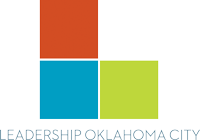Leadership Moments
Leadership Oklahoma City’s direct involvement in community improvement defies simple categorization. Over the past forty years, LOKC has partnered with other organizations, created its own projects, and provided additional volunteer manpower to existing projects. The only common thread among them is that there was a thoughtful assessment of the best way for Leadership Oklahoma City to involve itself in a particular initiative.
In 1993, Leadership Oklahoma City, the Oklahoma City Community Foundation, and the Association of Central Oklahoma Governments partnered to produce a community strategic plan. Central Oklahoma 2020 was peopled by “stakeholders,” corporate executives, civic volunteers, educators, retirees, elected officials, small business owners, immigrants and lifelong Oklahomans. These visionaries met for a year, and when they finished, twelve initiatives had been identified. These initiatives were strategic steps to a better central Oklahoma and included ideas that matured into a one-stop 24-hour juvenile intake center, a Mayors’ Round Table, increased civic support of infrastructure maintenance, a “Quality of Life Report Card,” and innovative changes in our public education system.
Two years later, the bombing of the Murrah Federal Building rocked Oklahoma City. That summer, a Leadership Oklahoma City graduate conveyed the offer of four nationally known speakers to present a free series of workshops to city employees and others as a way of re-igniting morale. An alumni committee went to work to design a showcase for the generous offer. Beyond April 19 featured former Vietnam POW Jerry Coffee, psychologist Judi Craig, management consultant Matt Weinstein, and writer Charles Garfield.
Class projects have sometimes been less a formal project and more a recruitment of class members to involve themselves in a common endeavor. In 1994, the Youth Leadership Exchange was founded at the local chapter of the American Red Cross and quickly adopted by many Class XIII members. They and others formed the steering committee and then the Advisory Board, raised much of the funding, designed and ran the project. Two years after is founding, YLX was formally adopted by Leadership Oklahoma City as its youth programming arm, and in 2002, three innovative programs for local high school students are available through YLX.
Another project originally housed at the American Red Cross, the Volunteer Center of Central Oklahoma, received the same sort of attention from Class XV. Class members created a new Advisory Council for the project, raised money, redesigned the volunteer recruitment processes to encompass new web-based technology, and eventually spun the project off into an independent organization.
In the 1980s, state and city leaders had been thinking about how to move Oklahoma City and Oklahoma into a position of excellence in the sciences.
Actually, it was all about brains. Topping the to-do-list was giving young brains specialized training and then stopping the “brain drain” from Oklahoma by interesting them in Oklahoma colleges and universities.
And as the idea crystallized, some Leadership Oklahoma City participants in Class V put their brains to work to get this specialized school located in the metro area. They included chairman Ann Ackerman and members Ron Bogle, Steve Lynn, Mark Robertson, Mary Delle Stelzer, Vicki Miles-LaGrange, and Hershel Lamirand who formed a committee to see what they could do.
For over a year they worked with the legislatively appointed selection committee, fighting off bids from Stillwater, Edmond and Norman. In the final vote, the committee was deadlocked between OKC and Stillwater with one vote outstanding, that of Senator Penny Williams from Tulsa, who voted for the Oklahoma City location.
As a result, in the first 10 classes, 596 students have graduated from the Oklahoma School of Science and Math. OSSM, as it is fondly called, has produced 156 National Merit Scholars. Two students have been named National Presidential Scholars. The Oklahoma Medical Research Foundation has offered Sir Alexander Fleming Scholarship to 12 OSSM students. Nine students have graduated with appointments to the United States Naval Academy, seven to the United States Air Force Academy and one to the United States Military Academy at West Point. And hundreds have received other prestigious awards and scholarships. Best of all, 66 percent attend Oklahoma college and universities.
Also in the area of health and science, graduates of Leaderhsip Oklahoma City dtermined that there was a need for an endowed chair at teh University of Oklahoma College of Medicine in Moolecular Biology.
The Chair was originally funded at $750,000. Today, it is over $2 million and growing. The purpose was to help Oklahoma catch up in an area that is the fastest growing scientific arena. Leading the charge was Lynn Carrozza and a group of fellow LOKC Class V members, including Jack Mildren and David Rainbolt. To raise that much money in one year was challenging but they received much appreciated assistance from the former president of the Presbyterian Health Foundation, Ed Miller. As a result, the char was named for Miller.
LOKC grads have participated in many other ways in the health community, both professionally and as volunteers. But the above are two outstanding examples of the way our graduates have provided ongoing support for our community and our state in to the 21st Century.



